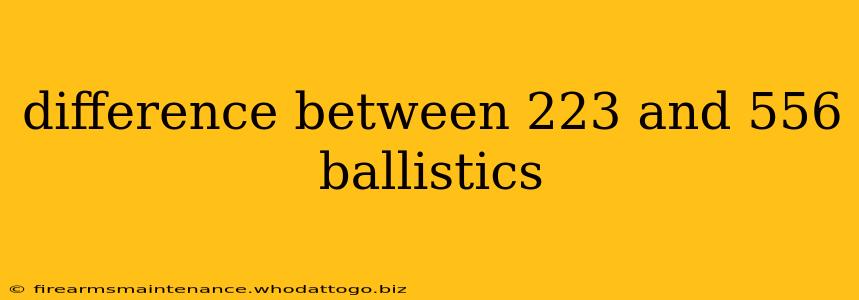The .223 Remington and 5.56x45mm NATO cartridges are often used interchangeably, leading to confusion about their ballistic differences. While visually similar, subtle variations in chamber dimensions and powder charges result in significant performance discrepancies, especially concerning pressure and accuracy. Understanding these differences is crucial for responsible firearm ownership and safe shooting practices.
Chamber Pressure: The Key Discriminator
The most significant difference lies in chamber pressure. The 5.56x45mm NATO cartridge is designed to withstand higher pressures than the .223 Remington. This is due to the slightly larger chamber dimensions of the 5.56, allowing for greater expansion of the propellant gases during firing. Firing a 5.56 round in a .223 chamber might not always result in catastrophic failure, but it significantly increases the risk of over-pressure, leading to:
- Increased risk of firearm damage: Excessive pressure can damage the barrel, action, or other components, potentially rendering the firearm unsafe or unusable.
- Reduced accuracy: The increased pressure can affect the bullet's trajectory, leading to inconsistent accuracy and reduced effective range.
- Increased recoil: The higher pressures often translate to a more pronounced recoil.
Conversely, firing a .223 Remington round in a 5.56mm chamber is generally considered safe, although not always recommended. The 5.56 chamber's larger dimensions can accommodate the .223 cartridge without exceeding safe pressure limits.
Bullet Velocity and Trajectory: Subtle yet Significant Variations
While the difference in chamber pressure is the most significant factor, it directly influences bullet velocity and trajectory. 5.56 rounds generally exhibit slightly higher velocities due to the higher pressure, resulting in a flatter trajectory and potentially longer effective range. However, this difference is not always dramatic and depends heavily on the specific ammunition load.
Ammunition Selection: The Importance of Matching Cartridge and Chamber
The safest practice is always to match the cartridge to the chamber specifications of your firearm. Firing ammunition not specifically designed for your firearm's chamber can lead to dangerous consequences. Always check your firearm's owner's manual for the recommended ammunition type.
Beyond the Basics: Factors Influencing Ballistics
Beyond the core differences between .223 and 5.56, other factors significantly influence ballistic performance:
Bullet Weight:
Heavier bullets generally have lower velocities but higher momentum, resulting in greater energy transfer upon impact. Lighter bullets achieve higher velocities but may have less stopping power.
Bullet Design:
The shape, material, and construction of the bullet significantly impact its aerodynamic properties and resulting trajectory. Full metal jacket (FMJ), hollow point (HP), and soft point (SP) bullets all exhibit different ballistic characteristics.
Powder Charge:
The amount of propellant used impacts both velocity and pressure. Variations in powder charge among different manufacturers can contribute to discrepancies in performance.
Conclusion: Know Your Cartridge
While the .223 and 5.56 cartridges appear similar, their ballistic differences are important. Understanding the implications of chamber pressure, velocity, and ammunition selection is crucial for safe and accurate shooting. Always consult your firearm's manual and prioritize safety above all else. Never compromise on safe gun handling practices.

